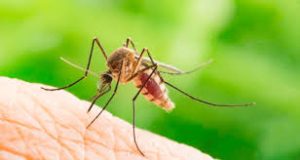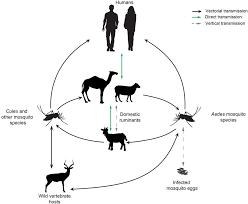
 Rift Valley fever (RVF) is a viral disease of humans and livestock that can cause mild to severe symptoms.
Rift Valley fever (RVF) is a viral disease of humans and livestock that can cause mild to severe symptoms.
The mild symptoms include: fever, muscle pains, and headaches which often last for up to a week.
Severe symptoms may include: loss of sight beginning three weeks after the infection, infections of the brain, causing severe headaches, confusion, bleeding and liver problems which may occur within the first few days.
Bleeding associated with a mortality as high as 50%.
The disease is caused by the RVF virus, spread by either touching infected animal blood, breathing in the air around an infected animal being butchered, drinking raw milk from an infected animal, or the bite of infected mosquitoes.
Contact with infected tissue is considered to be the main source of human infections.
Outbreaks of the disease have only occurred in Africa and Arabia.
Outbreaks usually occur during periods of increased rain which increase the number of mosquitoes.
Animals such as cows, sheep, goats, and camels may be affected.
Spread is mostly by mosquitoes.
It does not appear to be transmissible from one person to another.
The disease is diagnosed by finding antibodies against the virus or the virus itself in the blood.
Prevention of the disease in humans is accomplished by vaccinating animals against the disease.
Restricting the movement of animals during an outbreak may also be useful, as may decreasing mosquito numbers and avoiding their bites.
There is a human vaccine available that is not not widely available.
There is no specific treatment and medical efforts are supportive.
The virus can cause several syndromes.
Usually, there are no symptoms or only a mild illness with fever, headache, muscle pains, and liver abnormalities.
In a small percentage of cases (< 2%), the illness can progress to hemorrhagic fever syndrome, meningoencephalitis, or affect the eye.
Patients who become ill usually experience fever, generalized weakness, back pain, dizziness, and weight loss at the onset of the illness.
Typically recovery occurs within two to seven days after onset.
About 1% of people with the disease die of it.
In livestock, the fatality level is significantly higher.
Pregnant livestock infected with RVF abort virtually 100% of fetuses.
An animal disease epidemic of RVF is usually first indicated by a wave of unexplained abortions, and other
signs include vomiting and diarrhea, respiratory disease, fever, lethargy, anorexia and sudden death in young animals.
Rift Valley fever cause is the phlebovirus.
It is an order of enveloped negative single stranded RNA virus.
It delivers its genome into the host-cell cytoplasm by fusing their envelope with an endosomal membrane.
The virus is transmitted through mosquito vectors, as well as through contact with the tissue of infected animals.
Two species—Culex tritaeniorhynchus and Aedes vexans—are known to transmit the virus.
There are other mosquito vectors.
The virus has been isolated from two bat species, which are believed to be reservoirs for the virus.
RVFV’s RNA play an important role in the virus’ pathology, the nonstructural protein encoded on the S segment (NSs) has been found to directly affect the host.
NSs is hostile against the host interferon (IFNs) antiviral response.
NSs affects regular activity of double-stranded RNA-dependent protein kinase R, that is is involved in cellular antiviral responses in the host.
When RVFV is able to enter the host’s DNA, NSs forms a filamentous structure in the nucleus, allowing the virus to interact with specific areas of the host’s DNA that relates to segregation defects and induction of chromosome continuity.
This increases host infectivity and decreases the host’s antiviral response.
Diagnosis of Rit Valley Fever relies on viral isolation from tissues, or serological testing with an ELISA.
Other methods of diagnosis include Nucleic Acid Testing (NAT), cell culture, and IgM antibody assays.
Prevention includes taking measures to decrease contact with blood, body fluids, or tissues of infected animals and protection against mosquitoes and other bloodsucking insects.
Use of mosquito repellents and bed nets are two effective methods.
protective equipment to avoid any exposure to blood or tissues of animals that may potentially be infected is an important protective measure.
No vaccines are currently available.
RVF outbreaks occur across sub-Saharan Africa, with outbreaks occurring elsewhere infrequently.
Outbreaks usually correspond with the warm phases of the EI Niño, increase in rainfall, flooding and greenness of vegetation index, which leads to an increase in mosquito vectors.
